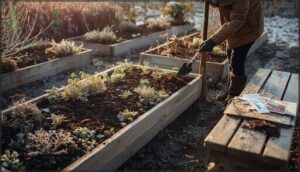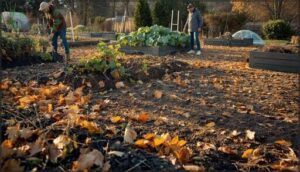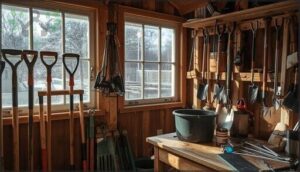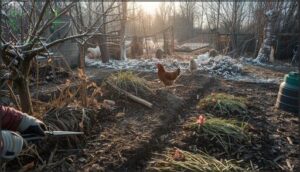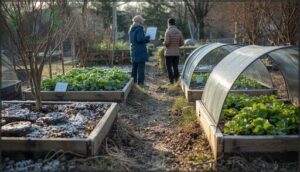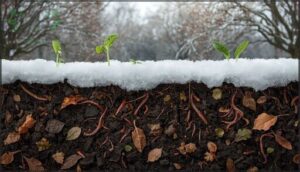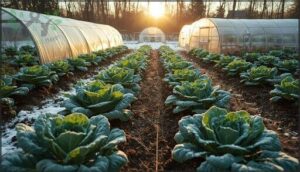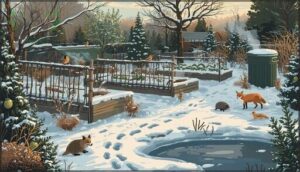This site is supported by our readers. We may earn a commission, at no cost to you, if you purchase through links.
 Most gardeners see winter as downtime, a season to retreat indoors and wait for spring. But here’s what permaculture designers know: winter is when the real soil building happens. While your garden sleeps above ground, you can set up systems that regenerate fertility, suppress weeds, and create conditions for explosive spring growth—all with less work than you’d spend fighting problems later.
Most gardeners see winter as downtime, a season to retreat indoors and wait for spring. But here’s what permaculture designers know: winter is when the real soil building happens. While your garden sleeps above ground, you can set up systems that regenerate fertility, suppress weeds, and create conditions for explosive spring growth—all with less work than you’d spend fighting problems later.
The trick isn’t fighting winter, it’s working with it. A layer of shredded leaves now decomposes three times faster than whole ones, cover crops planted in fall can fix nitrogen while you’re sipping hot tea, and a simple cold frame extends your harvest by months.
These winter permaculture gardening tips aren’t about coddling delicate plants through harsh weather—they’re about building resilient systems that thrive because of the cold, not despite it.
Table Of Contents
- Key Takeaways
- Essential Winter Garden Preparation Steps
- Protecting and Regenerating Winter Soil
- Extending The Winter Growing Season
- Sustainable Pest and Wildlife Management
- Top 7 Tools and Products for Winter Permaculture
- Frequently Asked Questions (FAQs)
- How to grow a garden in winter?
- What are winter garden tips?
- How can permaculture help a garden?
- How do I Keep my Garden warm during winter?
- How do you make a Winter Garden thriving?
- When should I start preparing my vegetable garden for winter?
- How do I Keep my Garden healthy in winter?
- How do you winterize a perennial garden?
- How do you keep plants warm in winter?
- How do winter rains affect garden drainage?
- Conclusion
Key Takeaways
- Winter isn’t garden downtime—it’s when the most critical soil-building happens through shredded leaf mulch (which decomposes three times faster than whole leaves), cover crops that fix nitrogen while dormant, and no-till compost applications that boost organic carbon by 25% over two decades.
- Season extension tools like low tunnels and cold frames can increase temps by 3-5°F and push harvests of cold-hardy crops (spinach, kale, mâche) well past first frost, with some structures boosting yields up to 188% while costing under a dollar per square foot.
- Proper winter prep—mulching after first frost, applying manure when soil drops below 50°F but before freezing, and rotating cover crops between beds—cuts spring weed germination by half, reduces irrigation needs by 30%, and can improve following-season yields by 4-6%.
- Natural pest management through winter relies on designing habitat for beneficial insects (beetle banks, flower strips), using physical barriers like buried wire mesh for burrowing animals, and letting prolonged cold naturally reduce pest populations instead of fighting them with chemicals.
Essential Winter Garden Preparation Steps
Winter might feel like a time to step away from the garden, but it’s actually when your most important work happens. The choices you make now—before the ground freezes—set the stage for healthier soil, fewer pests, and stronger crops come spring.
Winter is when your most important garden work happens—choices made before the ground freezes determine next season’s soil health, pest pressure, and crop vitality
Let’s walk through the essential steps that’ll help your garden rest, regenerate, and come back even more productive.
Assessing Garden Health and Soil Needs
Before you can chart a course forward, you need to know where you stand. Walk your garden beds and take stock without judgment—note areas showing pest pressure, depleted soil, or lingering disease. This honest assessment reveals which loops need closing.
- Test soil every 1–2 years, ideally in late fall, to check nutrient levels and pH
- Look for signs of compaction, poor drainage, or weak plant growth patterns
- Evaluate organic matter content—most gardens thrive with 2–6% to support soil health and microbial life
- Identify beds needing compost, cover crops, or regenerative practices to rebuild soil fertility before spring
Understanding your soil’s condition requires checking for soil test results to make informed decisions.
Timing and Prioritizing Winterizing Tasks
Once you know what your garden needs, frost date planning becomes your anchor. In zone 6b, mid-October signals the start—mulching after the first light frost firms the ground, while weeding beforehand stops invasives from taking deeper root.
Prioritize soil amendments and protecting plants from frost over smaller chores.
Climate adaptation means watching real-time signals, not just the calendar, when preparing your garden for winter and winterizing garden soil through regenerative timing. Effective winter preparation involves understanding key concepts like winter garden tips to guarantee a healthy garden.
Cleaning and Storing Garden Tools and Structures
Once the soil and plants are handled, your tools and structures need attention—neglecting this shortens their lifespan. Tool maintenance starts with soil removal, then disinfecting with diluted bleach for garden sanitation. Dry everything thoroughly for rust prevention, and apply oil to metal parts.
Store shovels, pruners, and raised bed hardware vertically in a dry spot; proper equipment care and storage solutions cut corrosion by nearly half over winter.
Weeding, Cutting Back Plants, and Livestock Cleanup
With tools stored, turn to weeds, pruning, and livestock grazing. Winter pruning promotes frost resistance and triggers higher starch reserves in woody plants. Removing weeds now, before they root deeper, cuts spring germination by half—mulch helps suppress regrowth. Let chickens or sheep clear spent beds, then compost their manure for soil regeneration.
Here’s your cold climate gardening checklist:
- Prune dormant perennials to boost carbohydrate storage and hardiness
- Pull winter annuals like chickweed before they set viable seed
- Rotate livestock through garden sections for natural cleanup
- Spread aged compost over cleared beds to feed spring microbiology
Planning Crop Rotation and Succession for Spring
Three-crop rotations lift soil organic matter by up to 32% and slash pest pressure by a third, so winter’s the time to map your spring beds.
Sketch succession planting timelines for lettuce and radishes at seven-day intervals, calculate last-sowing dates by counting back from frost, and pair legumes with grains to bank 55–81 kg nitrogen per season—your soil will thank you.
Protecting and Regenerating Winter Soil
Your winter soil is the foundation of next season’s abundance, so protecting and building it now pays dividends when spring arrives.
The cold months are actually your best opportunity to improve soil structure, add organic matter, and support the microbial life that makes everything grow.
Let’s look at five practical ways to keep your soil healthy and regenerating through winter.
Mulching Techniques for Cold Weather
When temperatures drop, your garden’s winter blanket makes all the difference. Apply 2-4 inches of straw, wood chips, or leaf mulch around trees and shrubs, keeping a buffer zone near stems to avoid decay. For vegetable beds, aim for 1-2 inches of organic covers.
Mulch stabilizes soil temperature, reduces frost heaving by moderating freeze-thaw cycles, and retains moisture through dormant months—giving roots the protection they need.
Shredding Leaves for Effective Mulch
Run your mower over fallen leaves before spreading them—shredded fragments decompose two to three times faster than whole ones, releasing nitrogen, phosphorus, and potassium throughout winter. You’ll gain three solid wins:
- Faster nutrient cycling as microbes attack the increased surface area
- Moisture retention improves by up to 70% compared to bare soil
- Weed suppression hits 84% when you lay a 2-4 inch blanket over beds
Using Cover Crops for Soil Health
Cover crops are regenerative farming’s secret weapon for winter soil health—plant them after harvest and watch them tackle soil erosion, build organic matter, and boost microbial diversity all season long.
Winter rye or hairy vetch will stabilize aggregates, cut erosion by 21%, and pump up bacterial abundance in just one year, setting you up perfectly for spring crop rotation.
No-Till Practices and Compost Application
No-till garden beds paired with winter compost application are carbon sequestration champions, locking away organic matter while microbial health flourishes. You’ll see:
- 25% more soil organic carbon after two decades of no-till composting methods
- 143% better aggregate stability from a single compost application
- 20% higher microbial activity in composted no-till soil
- 13% average yield increases across major crops
Skip the tilling, spread that compost tea-ready mulch, and let soil regeneration work its magic.
Manure and Organic Matter Management
Manure application in winter requires careful timing to avoid significant phosphorus losses, which can increase two to four times when applied incorrectly on frozen ground. The ideal window is after soil temperatures drop below 50°F but before the ground freezes. Here’s a decision matrix to guide your application:
| Application Timing | Nutrient Retention | Runoff Risk |
|---|---|---|
| Late fall (above 50°F) | Moderate | Low |
| Early winter (below 50°F) | High | Moderate |
| Frozen/snow-covered | Poor | Very High |
Before spreading manure, test both your soil and manure nutrient levels. When applied thoughtfully, organic fertilizers can enhance soil carbon and nutrient cycling, transforming potential pollution into effective compost management.
Extending The Winter Growing Season
You don’t have to let winter shut down your garden completely. With the right season extension tools, you can keep harvesting fresh greens and cold-hardy crops well past the first frost.
Let’s look at some practical ways to extend your growing season and make the most of your winter garden.
Building and Using Low Tunnels and Cold Frames
When winter settles in, low tunnels and cold frames become your secret weapon for extending the season. These simple structures bump daytime temps by 3–5°F, protect crops from pests, and can boost your crop yields dramatically—some growers see increases of up to 188%.
Best of all, material costs stay under a dollar per square foot, making season extension accessible without breaking the bank.
Choosing and Planting Cold-Hardy Crops
Once your structures are ready, the real fun begins: picking what to plant. Spinach, kale, and mâche can handle temperatures down to 20°F, while some Siberian kale cultivars survive 6°F.
Check your hardiness zone and planting timing—mid-August to early October works for very hardy winter crops.
Variety selection matters, too: ‘Winterbor’ kale and ‘Rouge d’Hiver’ lettuce excel under winter protection.
Rotating Winter Crops and Bed Rest Strategies
Now that you’ve selected your cold-hardy varieties, it’s time to think about how you’ll rotate winter crops and give certain beds a break. Bed resting and crop rotation boost soil rejuvenation, with winter cover strategies proven to:
- Increase soil organic carbon by 6–7% in one season
- Raise soil nitrogen up to 12.8% over fallow
- Improve following-season rice yields by 4.5–4.6%
- Reduce spring irrigation needs by 30%
- Cut winter weed emergence by 75%
Rotating your winter crops between beds—garlic here, a cover crop there—aligns with regenerative farming principles and keeps your system resilient.
Managing Water Systems and Frost Protection
Your irrigation system won’t make it through winter on its own. Drain and store hoses, soaker lines, and drip systems before the first hard freeze—frozen water inside tubing cracks it beyond repair.
Well-watered soil acts like a thermal battery, holding daytime warmth to buffer roots against frost. When temperatures dip below 40°F, water crops by midday so plants can absorb moisture and build nighttime insulation.
Leveraging Microclimates and Garden Layout
Garden orientation is crucial for a successful winter harvest. South-facing walls can increase soil temperatures by up to 3°C, reducing frost damage by a quarter.
Cluster beds near heat-storing rocks or water features to raise nighttime air temperatures by 1–2°C. Windbreaks are also essential, as they reduce wind speed by half, keeping soil moisture 12% higher.
To maximize your harvest, map your microclimates and place cold-sensitive crops closest to thermal mass. By implementing these strategies, you can stretch your growing season by up to three weeks.
Sustainable Pest and Wildlife Management
Winter pest management in permaculture isn’t about waging war on creatures, it’s about designing systems where everything has its place. You’ll work with wildlife to keep pests in check, protect your crops from hungry visitors, and even keep your compost systems running through the cold months.
Here’s how to create that balance in your winter garden.
Identifying and Addressing Winter Pests
Winter pests are quieter than their summer cousins, but they’re not gone. Understanding pest population dynamics and cold climate entomology helps you anticipate what survived the freeze—and what damage they’ll cause come spring. You’ll find soil-borne pests and aphids waiting under mulch or in protected spots, so managing garden pests now, while temperatures swing, saves you headaches later.
Here’s your winter pest control strategy:
- Scout early and often – Check under leaves, mulch, and near structures where slugs, stink bugs, and aphids hunker down for frost tolerance strategies.
- Let harsh cold do the heavy lifting – Prolonged sub-zero temps with minimal snow cover reduce pest populations naturally, disrupting their nutrient cycle.
- Plan integrated approaches – Combine weed control, crop rotation, and organic treatments like neem to keep pests below threshold without harming beneficial insects.
Creating Wildlife Habitats for Natural Pest Control
You can stack ecosystem services by building overwintering refuges right into your layout. Beetle banks, flower strips, and bat shelters invite beneficial insects and predators that crush pest populations come spring.
Leave leaf litter and logs near beds, add habitat structures along edges, and watch natural enemies multiply.
This integrated approach weaves wildlife habitat into your system, turning pest control into a year-round partnership.
Protecting Crops From Grazing Animals
Grazing animals can wipe out tender crops overnight, so effective wildlife management blends multiple layers. Deer deterrents like 7–8 foot fences work best when combined with electric fencing placed at nose height. Animal barriers—wire mesh buried 2–3 inches deep—stop burrowing voles and rabbits.
Integrating livestock like chickens or ducks for cleanup adds another dimension, turning crop protection into a resilient, multi-strategy system that guards your winter harvest.
Composting and Vermicomposting in Cold Weather
Cold composting slows dramatically below 50°F as microbes shift gears, but you can keep things moving with a few smart adjustments. Build piles at least 3′ × 3′ × 3′ to hold heat, insulate sides with straw bales or cardboard, and cover the top to shed moisture.
For winter vermicomposting, relocate bins indoors—worms thrive between 55–95°F but shut down when frozen soil management becomes necessary.
Top 7 Tools and Products for Winter Permaculture
You don’t need a shed full of fancy equipment to make winter permaculture work, but a few well-chosen tools can save you hours of labor and help you extend the season with less guesswork.
The right mulcher turns leaf piles into soil gold faster, while quality row covers and hoops protect your crops without constant babysitting.
Here are seven tools and products that actually earn their keep in a cold-climate garden.
1. Cordless Leaf Vacuum Mulcher Tool
You might think fall leaves are just a mess, but they’re actually raw material for one of your best soil-building moves. A cordless tool like the RYOBI 40V leaf vacuum mulcher converts bulky piles into fine mulch at a 15:1 ratio, so you’re turning twenty bags of leaves into one bag of compost-ready material.
Battery efficiency and tool ergonomics make cleanup faster, the electric mulching leaf blower runs quietly, and shredded leaf mulch insulates beds while feeding soil life through winter.
2. Floating Row Crop Cover Fabric
While mulched leaves feed the soil from below, floating row crop cover fabric protects what’s growing above. This lightweight polypropylene material lets 70–85% of sunlight and rain through while giving you 4–6°F of frost protection, enough to push cold weather crops like spinach and kale into December or later.
Secure it over your beds with hoops or wire, and you’ve created a microclimate that extends your season without blocking the elements your winter crops need to thrive.
3. Four Season Organic Gardening Guide
You can protect your beds with fabric and hoops, but knowing which crops to plant when—and how to rotate them through the season—takes a system. That’s where Eliot Coleman’s Four-Season Harvest comes in.
This guide walks you through year-round organic methods, crop rotation strategies, and soil fertility practices that keep your permaculture garden productive even in the depths of winter. It’s conversational, tested in zone 5, and full of practical season extension techniques for cold weather crops.
4. Gardener High Rise Support Hoops
Once you know what to plant, you’ll need sturdy hoops to hold your row covers through snow and wind. Gardener high rise support hoops—made from powder-coated steel with cross braces—give you 43 inches of headroom over a three-foot bed, plenty of room for taller kale or overwintering carrots.
They’ve been tested to handle 50 pounds of snow per square foot, and metal conduit versions can last over a decade. Pair them with floating fabric, and you’re looking at an extra four to eight weeks of harvest.
5. Galvanized Steel Craft Wire
Sometimes you need something more flexible than steel hoops—that’s where galvanized steel craft wire comes in. You can bend it into custom shapes for trellising winter greens, weaving crop support frames, or repairing existing structures when snow damage happens.
The galvanized coating withstands moisture without rusting, and because it’s 100% recyclable, it fits nicely into a closed-loop permaculture garden.
One spool can patch a cold frame, stake a row of overwintered garlic, or build makeshift cloches over tender soil and compost zones.
6. Reusable Floating Garden Cover Fabric
You can drape reusable floating garden cover fabric right over kale, spinach, and other cold weather crops without needing hoops. The breathable material lets light, air, and moisture through while offering 4–6°F of frost resistance, protecting tender growth during sudden cold snaps.
Fabric durability matters—well-maintained row covers last three to five years, cutting down on single-use plastics and making winterizing more affordable over time. Think of it as garden insulation you roll out in fall and tuck away in spring, a straightforward season extender that works quietly all winter.
7. Frost Protection Plant Cover Fabric
Heavy-weight frost fabric delivers 8°F of temperature buffering when temperatures drop hard and fast, offering more protection than standard row cover for crops on the edge of their hardiness zone.
You can layer it over low tunnels or cold frames to push season extenders further into winter, or wrap it around polytunnel frames to shield cold-sensitive starts.
The trade-off is reduced light transmission—around 50%, so it works best for short bursts of frost protection rather than all-season use in winter greenhouses.
Frequently Asked Questions (FAQs)
How to grow a garden in winter?
Winter gardening thrives when you select cold-hardy vegetable varieties—like spinach and kale—and extend your season with low tunnels or a well-designed cold frame that maintains stable soil temperatures and protects against frost.
What are winter garden tips?
Start with soil preparation for winter growing—add compost, mulch heavily, and protect plants from cold using row covers.
Winter garden planning includes tool winterization, frost protection methods, pest management, and maintaining soil health throughout the season.
How can permaculture help a garden?
You design garden systems that work with nature, not against it. Permaculture boosts soil health, conserves water, enhances biodiversity, and increases yields—all while using techniques like mulching, manure application, and natural pest control.
How do I Keep my Garden warm during winter?
You’ll want to layer on mulch—straw or wood chips work beautifully—and set up cold frames or low tunnels.
These season extenders can boost soil temps by several degrees, giving your cold weather crops solid frost protection.
How do you make a Winter Garden thriving?
You make a winter garden thrive by choosing cold-hardy crops, managing soil temperature with mulch, protecting plants from frost, and applying regenerative practices—all while designing your permaculture garden around your unique cold climate conditions.
When should I start preparing my vegetable garden for winter?
Your garden’s ready for winter the moment fall rolls in—mid to late autumn, ideally a few weeks before frost hits. Timing matters: mulch after hard frosts, install cold frames early, and prep soil while temperatures cooperate.
How do I Keep my Garden healthy in winter?
Keep your permaculture garden healthy through winter by applying mulch for soil insulation, protecting crops with frost barriers, pruning damaged growth, adding compost, and selecting cold-hardy varieties that support garden renewal.
How do you winterize a perennial garden?
It’s funny how winterizing perennials mirrors tucking in for the season yourself. You’ll prune back dead stems in late winter, mulch crowns 2-3 inches deep after the first hard frost, and remove debris to prevent disease overwintering.
How do you keep plants warm in winter?
Your best tools are insulation and microclimates: layer straw mulch or shredded leaves around roots, use row covers for 2-8°F of frost protection, and shelter cold-hardy vegetables under low tunnels or cold frames.
How do winter rains affect garden drainage?
Winter rains have a dual impact on soil health. They can temporarily reduce soil compaction, which improves water infiltration and aeration. However, heavy saturation overwhelms drainage systems, particularly in clay soils, leading to waterlogging, root damage, and increased erosion without proper management.
Conclusion
Winter’s dormancy is just surface-level illusion—beneath the frost, your garden is quietly transforming. Every layer of shredded leaves, every cover crop root breaking through compacted soil, every protected bed is banking fertility for the explosion ahead.
These winter permaculture gardening tips aren’t about surviving the cold months—they’re about engineering abundance while nature does the heavy lifting. Come spring, you won’t be starting from scratch. You’ll be harvesting momentum.
- https://peercommunityjournal.org/articles/10.24072/pcjournal.521/
- https://descendingthemountain.org/resources/permaculture-and-the-edible-forest-garden-a-critical-analysis/
- https://digitalcommons.wku.edu/cgi/viewcontent.cgi?article=1823&context=stu_hon_theses
- https://pmc.ncbi.nlm.nih.gov/articles/PMC7004306/
- https://www.johnnyseeds.com/growers-library/methods-tools-supplies/winter-growing-season-extension/10-ways-extend-your-season.html

